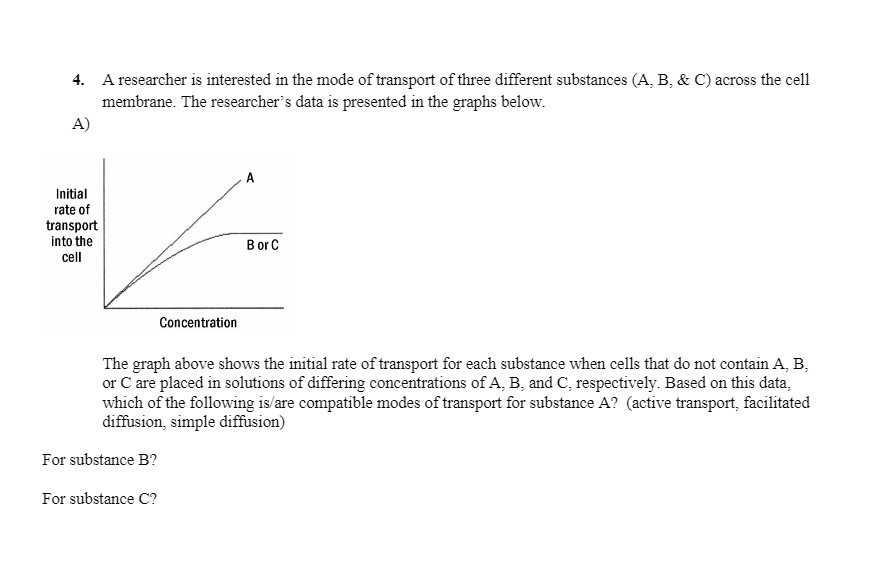4. A researcher is interested in the mode of transport of three different substances (A, B, & C) across the cell membrane. The researcher's data is presented in the graphs below. A) A Initial rate of transport into the Bor C cell Concentration The graph above shows the initial rate of transport for each substance when cells that do not contain A, B, or C are placed in solutions of differing concentrations of A, B, and C, respectively. Based on this data, which of the following is/are compatible modes of transport for substance A? (active transport, facilitated diffusion, simple diffusion) For substance B? For substance C?
4. A researcher is interested in the mode of transport of three different substances (A, B, & C) across the cell membrane. The researcher's data is presented in the graphs below. A) A Initial rate of transport into the Bor C cell Concentration The graph above shows the initial rate of transport for each substance when cells that do not contain A, B, or C are placed in solutions of differing concentrations of A, B, and C, respectively. Based on this data, which of the following is/are compatible modes of transport for substance A? (active transport, facilitated diffusion, simple diffusion) For substance B? For substance C?
Human Physiology: From Cells to Systems (MindTap Course List)
9th Edition
ISBN:9781285866932
Author:Lauralee Sherwood
Publisher:Lauralee Sherwood
Chapter3: The Plasma Membrane And Membrane Potential
Section: Chapter Questions
Problem 1TAHL: Which of the following methods of transport is being used to transfer the substance into the cell in...
Related questions
Question

Transcribed Image Text:4. A researcher is interested in the mode of transport of three different substances (A, B, & C) across the cell
membrane. The researcher's data is presented in the graphs below.
A)
A
Initial
rate of
transport
into the
Bor C
cell
Concentration
The graph above shows the initial rate of transport for each substance when cells that do not contain A, B,
or C are placed in solutions of differing concentrations of A, B, and C, respectively. Based on this data,
which of the following is/are compatible modes of transport for substance A? (active transport, facilitated
diffusion, simple diffusion)
For substance B?
For substance C?
Expert Solution
This question has been solved!
Explore an expertly crafted, step-by-step solution for a thorough understanding of key concepts.
This is a popular solution!
Trending now
This is a popular solution!
Step by step
Solved in 3 steps with 2 images

Knowledge Booster
Learn more about
Need a deep-dive on the concept behind this application? Look no further. Learn more about this topic, biology and related others by exploring similar questions and additional content below.Recommended textbooks for you

Human Physiology: From Cells to Systems (MindTap …
Biology
ISBN:
9781285866932
Author:
Lauralee Sherwood
Publisher:
Cengage Learning

Biology: The Dynamic Science (MindTap Course List)
Biology
ISBN:
9781305389892
Author:
Peter J. Russell, Paul E. Hertz, Beverly McMillan
Publisher:
Cengage Learning

Biology 2e
Biology
ISBN:
9781947172517
Author:
Matthew Douglas, Jung Choi, Mary Ann Clark
Publisher:
OpenStax

Human Physiology: From Cells to Systems (MindTap …
Biology
ISBN:
9781285866932
Author:
Lauralee Sherwood
Publisher:
Cengage Learning

Biology: The Dynamic Science (MindTap Course List)
Biology
ISBN:
9781305389892
Author:
Peter J. Russell, Paul E. Hertz, Beverly McMillan
Publisher:
Cengage Learning

Biology 2e
Biology
ISBN:
9781947172517
Author:
Matthew Douglas, Jung Choi, Mary Ann Clark
Publisher:
OpenStax

Biology: The Unity and Diversity of Life (MindTap…
Biology
ISBN:
9781305073951
Author:
Cecie Starr, Ralph Taggart, Christine Evers, Lisa Starr
Publisher:
Cengage Learning

Anatomy & Physiology
Biology
ISBN:
9781938168130
Author:
Kelly A. Young, James A. Wise, Peter DeSaix, Dean H. Kruse, Brandon Poe, Eddie Johnson, Jody E. Johnson, Oksana Korol, J. Gordon Betts, Mark Womble
Publisher:
OpenStax College

Biology: The Unity and Diversity of Life (MindTap…
Biology
ISBN:
9781337408332
Author:
Cecie Starr, Ralph Taggart, Christine Evers, Lisa Starr
Publisher:
Cengage Learning